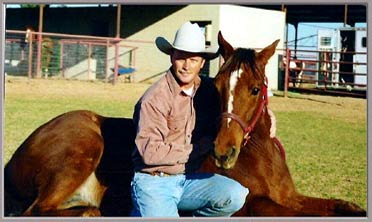|
Horse Trainer Self Control. My horse is stuck! By Steve Sikora
 |
If you have been riding long and have tried to teach your horse something new, no doubt you have run into the stumbling block where
the horse seems to get stuck. Sometimes it is as if the horse is not only, not learning, but seems to be regressing. It may be that we are
trying something new in the round pen and the horse is not getting it, and then we are not able to get the horse to do something that they have done before and we thought that they knew.
This is when frustration sets in for most people. It would be easy to take our frustration out on the horse. It is much more fruitful at
this time to take a step back, to remove our emotion from the training, and regroup.
Once our emotion is up, teaching becomes very ineffective. The best solution for all involved is to stop and take a break, and give us the needed space to cool down. We do not need to end on a good note, trying to get to that good spot may cause more problems.
And horses are so adaptable that they can learn or relearn a lesson easily.
While this concept sounds simple on the surface, it is much harder to implement. Many people have trouble recognizing that their own
emotion is elevated. One of the signs that our emotion is elevated is when we find ourselves thinking, “the horse knows this, so why
are they not doing performing as I know they can.” When we are thinking this way, we are taking our horse’s lack of performance
personally, as though they are doing something to us. Horses are not vindictive; they want to get along with us, and to please. The
reality is that we have not taught the lesson to the level where the horse can give us a “yes” or correct answer. For example someone
may be able to target shoot at the range and never miss. In fact they may be able to shoot a really tight pattern close to the bull’s-eye.
That same person out hunting, however, may get “buck fever” when attempting to shoot a live animal and miss completely. When a
horse’s emotion becomes elevated, their performance drops off. Just like the hunter that misses when shooting at a live animal. This
does not mean that our hunter did not learn to shoot, just that they have not practiced enough in a raised emotional state to be proficient.
This does not mean we have not worked the lesson with our horse. In fact the horse may have been doing a good job with the lesson
the last time that we worked on it, but that was last time. Many people experience the same phenomenon when learning math, or
tying knots. When the teacher shows us how to do a problem on the board, it makes sense. We may even do some in class on our
own, but when we sit down to do our homework it is as if we learned nothing, it just does not look the same anymore. So when the
horse we are working with acts as though they have never seen the lesson, have patience with them.
In order for the horse to learn and be able to move forward through the lesson, it is necessary to go back to where the horse can give us the yes or correct answer. So how far back in our training do we need to go? It depends on the horse. This is a probing project.
We must go back one step at a time in order to find the spot where we get the yes answer.
Once we get the yes answer, we can build from there. We can then go through one step at a time, following our lesson plan, to get
the horse back to where they can perform as they had previously. If the horse gets stuck again, it may be that we are trying to take
too big a step. Our lesson plan may need some adjustment in order for the horse to learn this lesson.
Horses are just like people, all individuals. Some can learn a given lesson only using steps one, three, five and seven. Skipping steps
two, four and six. Some will need all seven steps. And still others will need all seven steps further broken down into half steps. Be
patient and add steps as necessary, it will allow the horse to learn more quickly than pounding on a lesson that is not working.
By being vigilant as to when our horse becomes stuck, when our emotion is elevated, going back to where we can get a yes answer
form the horse, and when it is in the horses best interest to add steps to our lesson plan, we can get the stuck horse back on the learning track.
No matter how many steps it takes to teach the horse, we get to spend some great time with these wonderful animals outside in the fresh air. It beats any office job that I can think of.
|